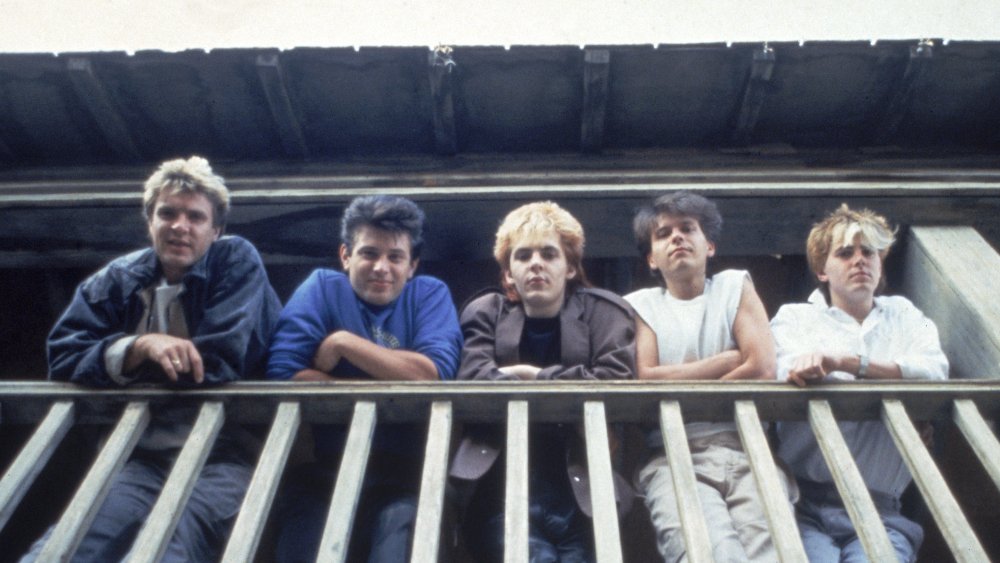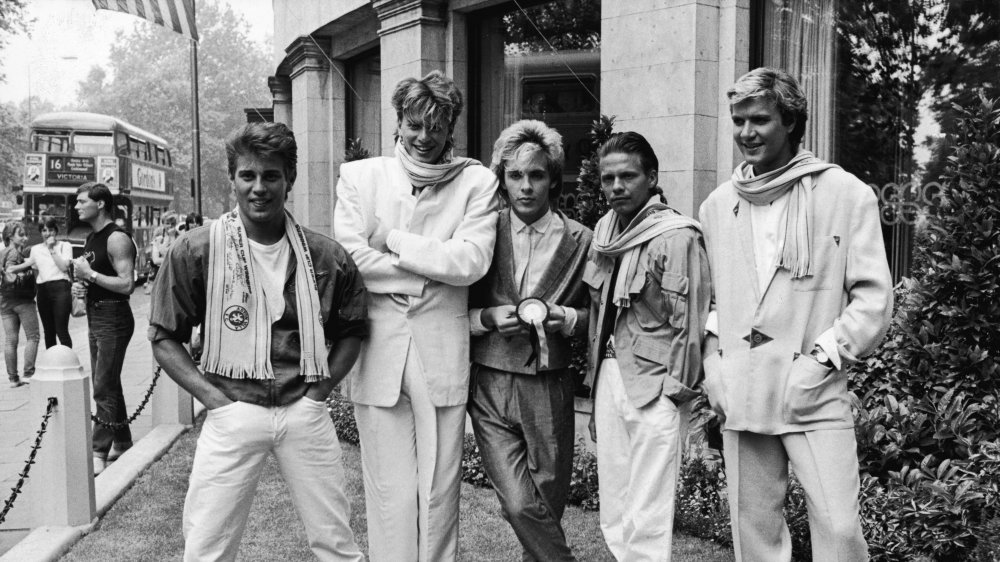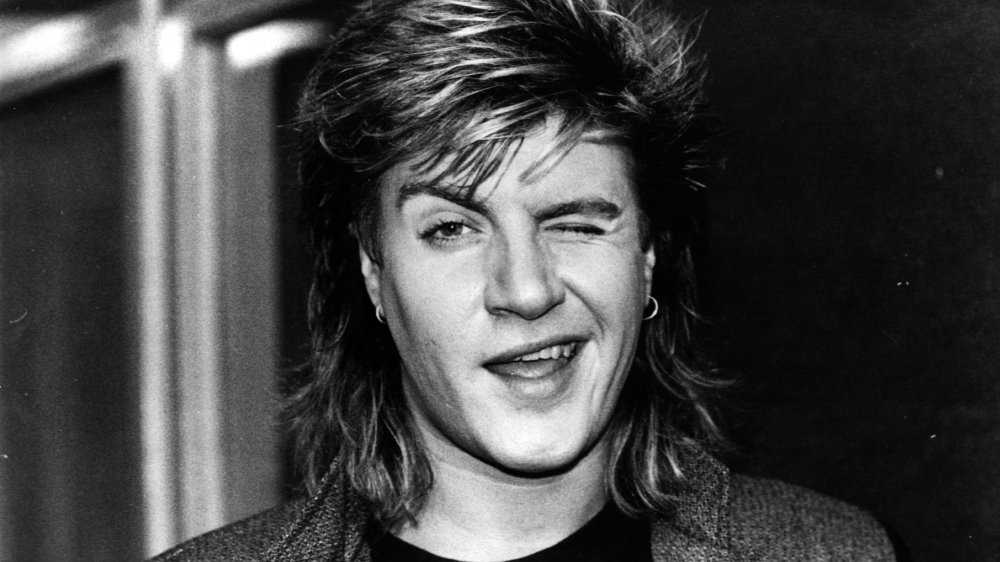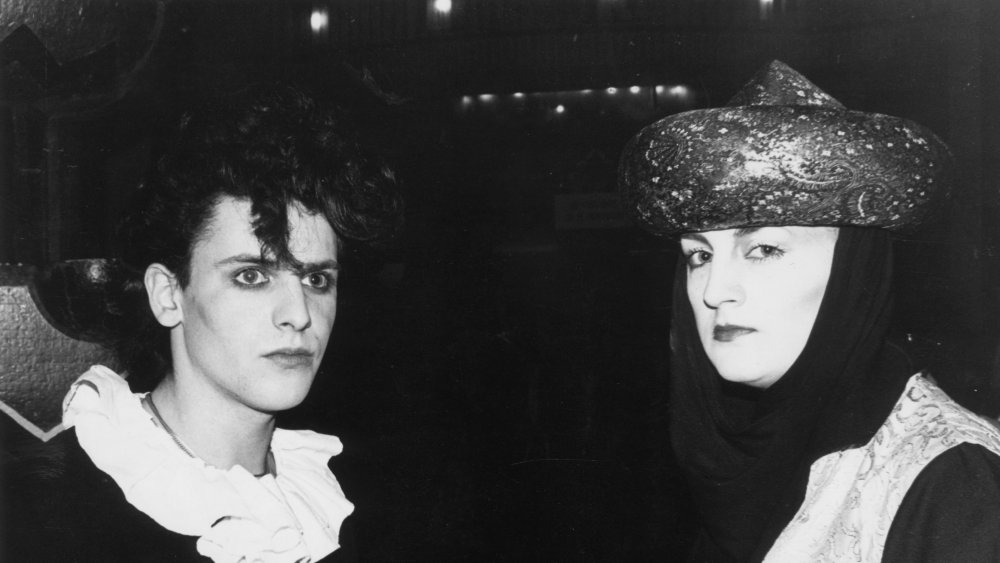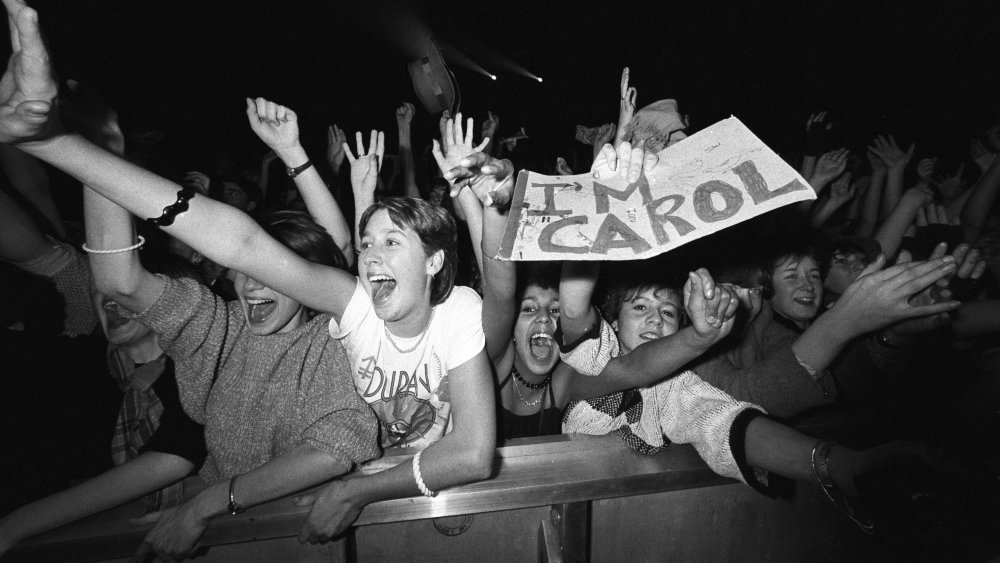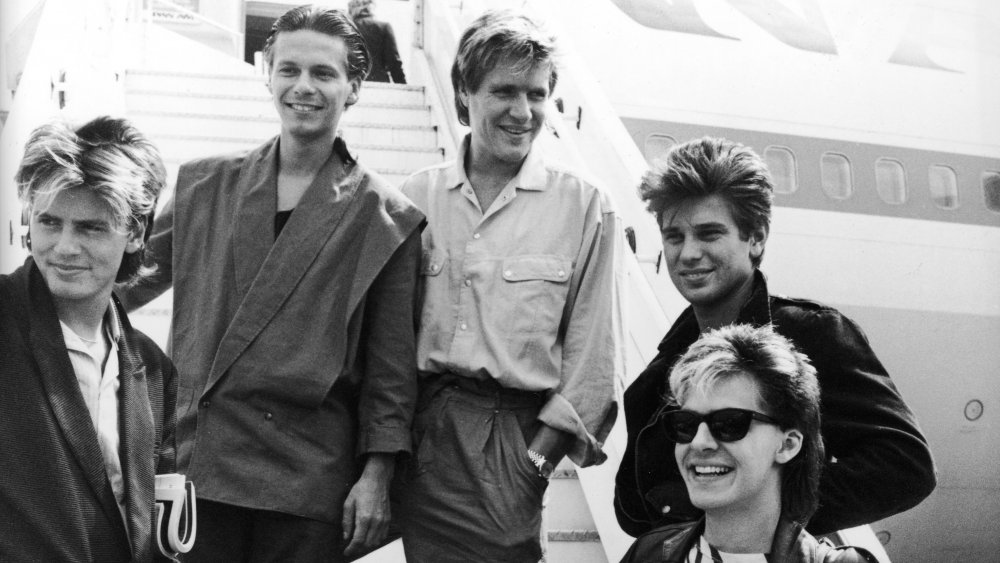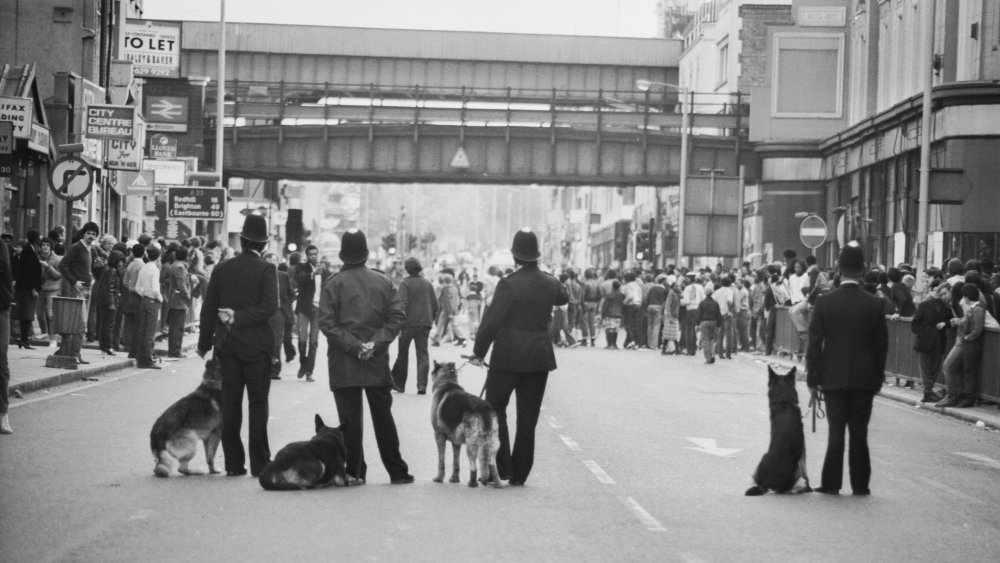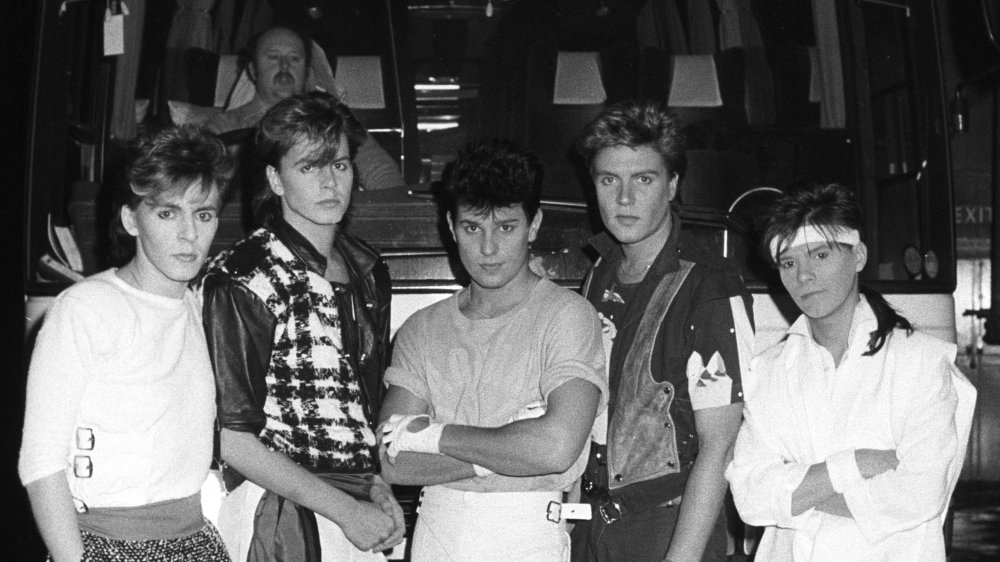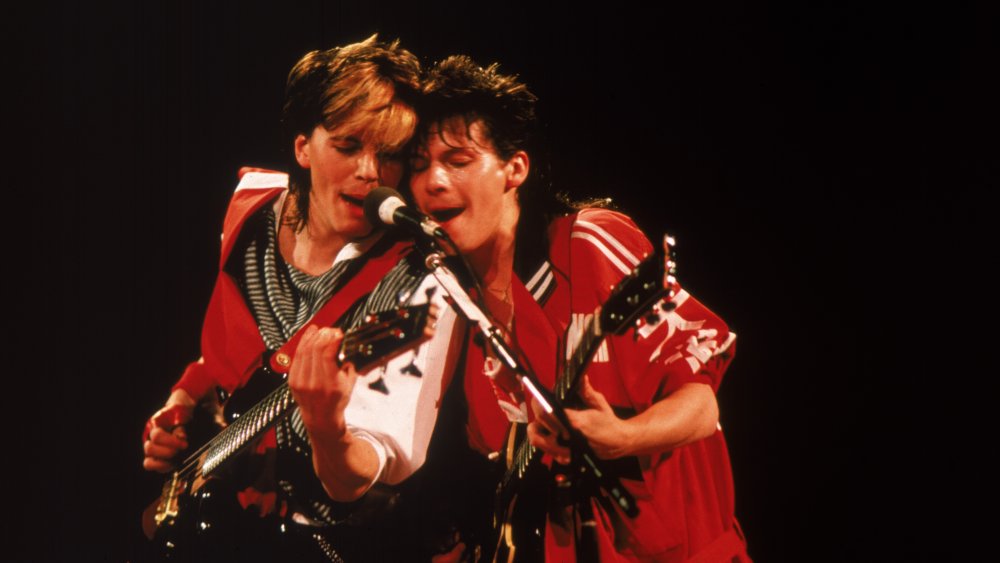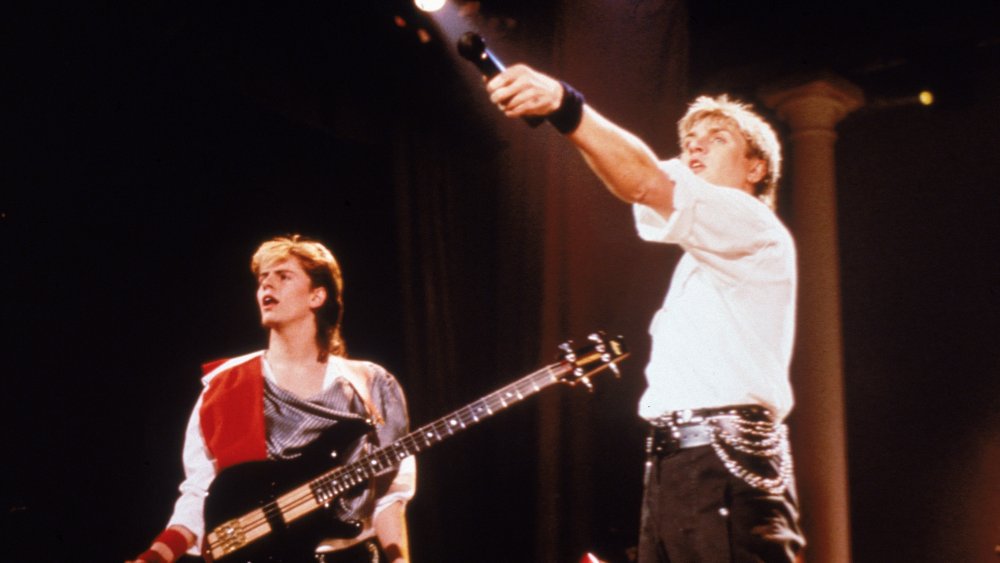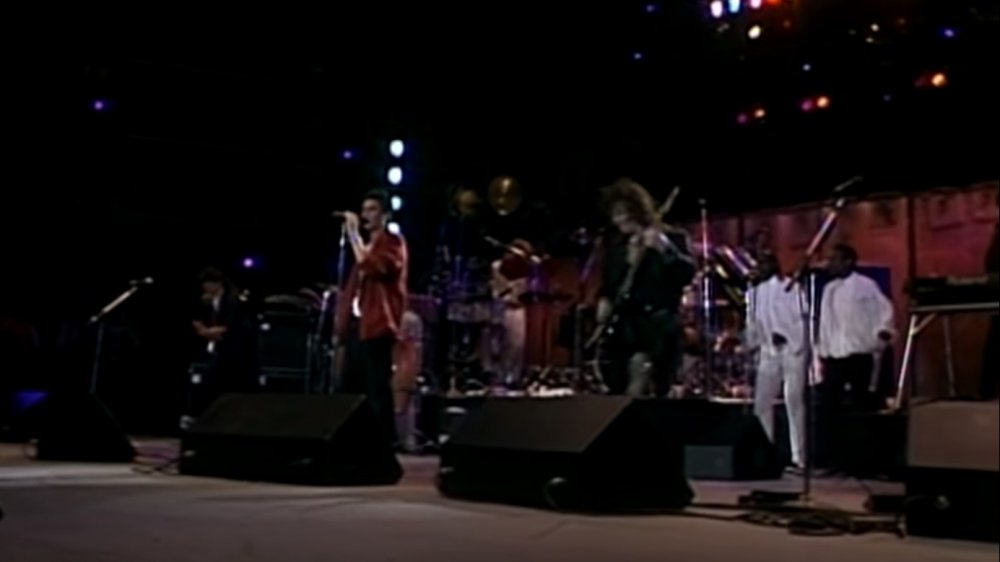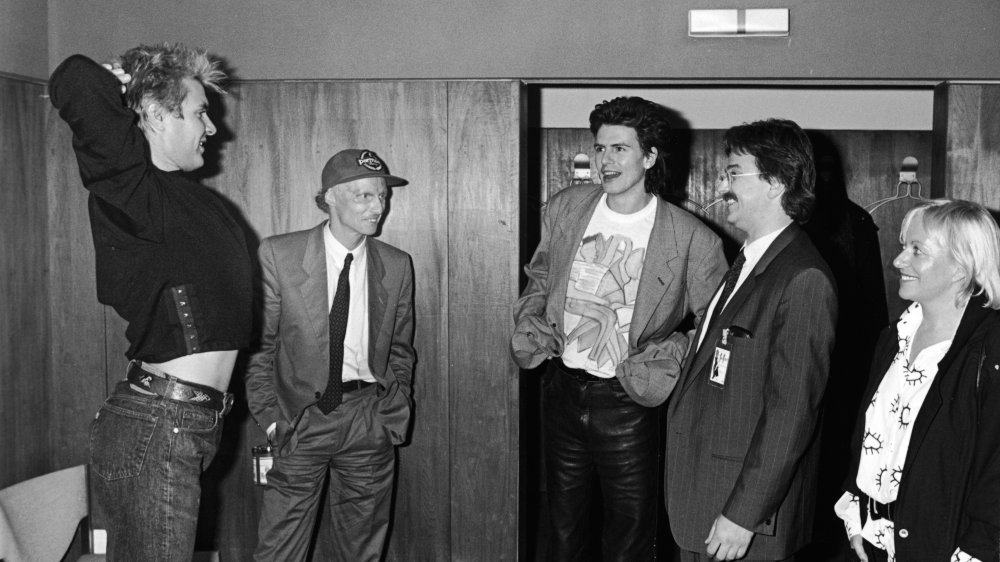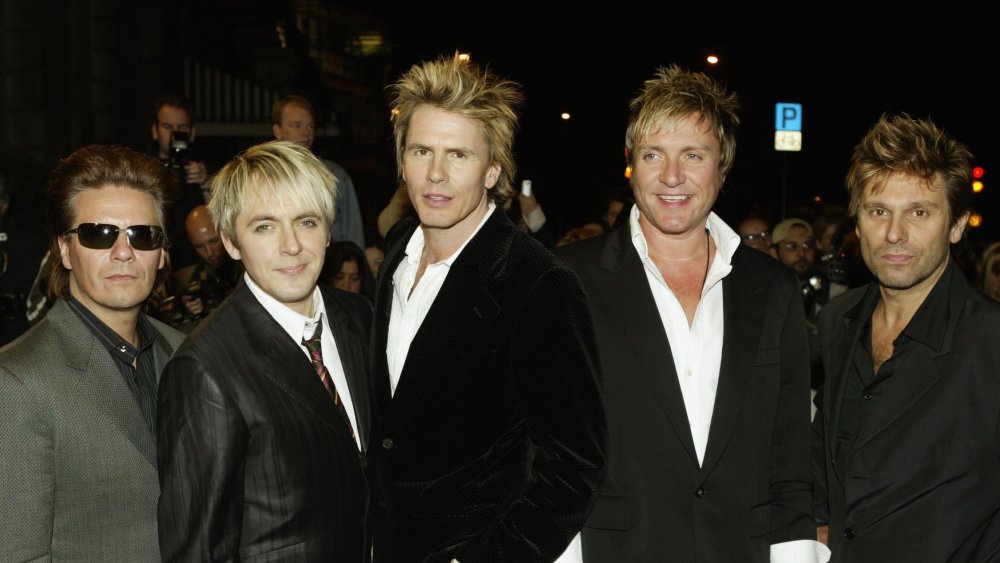The Crazy Real-Life Story Of Duran Duran
In many ways, Duran Duran was the 1980s. A new wave band from England who hit it big in the MTV era because of their slick, professional music videos (in a time when most were just cheap recordings of bands playing live) and extremely sharp fashion sense, Duran Duran was one of the biggest bands of the decade. And, unlike a great many 80s bands, they actually managed to come out of that era and keep making music, albeit not without a lot of trials and tribulations, after it ended.
All of that paid off with two Grammys, a star on the Hollywood Walk of Fame, and several million records sold. They also released an absolute banger of a James Bond theme, a feat few musicians can claim.
But along the way, Duran Duran encountered some events that would have shattered lesser bands. They really did it all and looked great doing it.
Duran Duran started out as nightclub employees
Like all bands, Duran Duran had to start somewhere. In 1978, at the Rum Runner, one of the hottest nightclubs in Birmingham, UK, a group of young musicians began playing shows while working as employees in their spare time. They named themselves after a minor character from the film Barbarella (which itself was also the name of another popular Birmingham nightclub), Durand-Durand, but tweaked the name a little to become Duran Duran instead.
Even after seeing some success, the band members, Stephen Duffy, Nick Rhodes, Andy Taylor, Roger Taylor, and John Taylor (please note that, shockingly, none of these Taylors are related) helped out at the nightclub as bouncers, DJs, bartenders, and even glass collectors.
The band's first managers were actually the Rum Runner's owners, Paul and Michael Berrow, and Duran Duran became a sort of house band for the club, performing at night and working the rest of the time. The Berrow brothers helped Duran Duran record a new demo tape, which they then sent out to labels throughout the industry, all while continuing to polish glasses and work as short order cooks at the Rum Runner. Even after they hit it big, the band never forgot the club, and would hold after-parties there whenever they played Birmingham, according to the Birmingham Mail.
Duran Duran had a tough time finding a singer
The band's initial singer, Stephen Duffy, was a student at the local college, Birmingham Polytechnic, but alas, left Duran Duran, the college, and the town before they hit it big when he moved on to a rock group called Obviously Five Believers. This left a vacancy which was filled by Andy Wickett, previously the singer of another local band named TV Eye, according to Cryptic Rock. It was, in fact, Wickett who co-wrote the band's first huge hit, "Girls on Film," and sang on the original demo track, which had a bit of a darker sound compared to the final release.
Wickett departed after a short time to pursue other genres, and claims he has actually never listened to a Duran Duran record since he's not really into that style of music. It probably worked out for the best, in that case, and so Duran Duran once again had to hunt for a singer, but at least this would be the last time they needed to do so, even if they didn't know that yet.
They worked with a few vocalists during this time before a fellow Rum Runner employee introduced them to her boyfriend, a London-based singer named Simon Le Bon in 1980, who would soon become the band's permanent frontman and one of the most famous voices of the 1980s. Le Bon liked the band's style and immediately jumped on board.
The New Romantics who were not
While 80s pop music might all appear to be one, unified genre, it is most assuredly not. Even in the dawn of the decade, there were already an uncountable number of tiny subgenres of synth pop, post punk, new wave, and so on. Birmingham was considered a hotbed for one particular movement, the New Romantics.
Taking a page out of David Bowie's glam rock book from previous decades and the original Romantic movement of the early 19th century, New Romantics put on theatrical, garish costumes with lots of ruffles and wrote songs about, well, romance mostly. Duran Duran was considered one of the poster children of the New Romantic movement, as they were right there at the forefront when it began to build steam. While popular, the genre never won over critics who thought it was far more about style than substance and, to be fair, they weren't exactly wrong about that, either.
So, when the New Romantic fad began to dry up within a few short years, Duran Duran was suddenly left looking terribly uncool. Upon reaching global fame, it didn't take long for the band to ditch the ruffles and start on a different path: high fashion. According to Decider, the band quickly began wearing designer suits and cutting-edge couture. Their first recording contract is alleged to have even had a clothing budget built into it.
Duran Duran's problem with being good-looking
Speaking of Duran Duran's New Romantic days, there was another aspect of this type of fame that haunted the band later on. During this phase, the band, like many other New Romantics, were considered teen idols, and often ended up in cheesy teen magazines like Tiger Beat, where they would pose and look all sultry, stuff that decidedly had nothing at all to do with music but made them very popular anyway.
Along with the critical disdain New Romantics received, mockery was especially reserved for the musicians who involved themselves in these cornball photo spreads, according to Huffington Post. This was a problem for Duran Duran because, frankly, the entire band was considered extremely attractive at the time. They had done tons of photos like these because it paid the bills and because being extremely attractive was a good thing for New Romantics.
It sounds like a good problem to have, but when the band decided to mature their sound, they ran into a lot of trouble with people bringing up their old photo shoots and assuming they were a vapid proto-boy band, and not serious musicians. It took them literal years and several huge hits for people to not just assume they were a quintet of dumb models who pretended to play instruments to look good in music videos on occasion. Ah, the perils of being really, really, ridiculously good-looking.
Girls on (music) video
And speaking of music videos, around the same time that Duran Duran was making a splash, a cable network called MTV had burst onto the scene and promptly changed everything about the music industry. If you were alive back then, you'll know that's not an exaggeration in the slightest. MTV was the 800 pound gorilla of 80s music. It was a cut-throat, make it or break it world when it came to music videos, as now bands didn't just have to have great songs, they had to look the part, too. Video did kill the radio star, after all.
Duran Duran was in a good position to take full advantage of this, and they did later on, but when it came to their first big single, 1981's "Girls on Film," the band had a huge problem. Since they got their start in nightclubs, and many clubs had installed huge video screens in the early 80s, Duran Duran made a music video for, well, nightclubs. The decidedly R-rated video included mud wrestling, some kinky stuff, and yes, actual nudity, according to the AV Club.
But MTV wouldn't air it, and since MTV became the de facto market for videos basically overnight, the band had to scramble to produce an edited, safe-for-broadcast version. Thankfully, this worked out okay, but it did have the interesting side effect of the original video becoming a sort of urban legend, with all sorts of rumors about what it contained.
When the riot at a Duran Duran concert wasn't the fans
After their self-titled first album was a hit, Duran Duran did what every enterprising young band does and went on tour. The shows were sold-out affairs, and as the band got more and more in-demand, they needed to put on more shows. It so happened that in 1981, they undertook their second tour of their home country of England.
But this tour was a bit different from their previous one. 1981 was famous in the UK for a series of riots relating to questionable leadership, poverty, inequality... you know, the things people tend to have riots over. So alongside the band's summer tour dates, numerous spots throughout England had active, ongoing riots.
The band got some moderate criticism for continuing their tour anyway, but one particular move got them in some hot water — they played a show in their hometown of Birmingham on the same night a riot was occurring. According to The Quietus, the band could actually hear the riot going on outside while they rehearsed, but the show must go on, and it did regardless. This got them some pretty scathing remarks from the press. After all, it's not a good look for a band that emphasizes high fashion and a decadent lifestyle to continue performing in the middle of a lot of poor people rioting at their terrible conditions.
A beautiful chateau in France and tax evasion
After Duran Duran's second album, Rio, did even better than their first one, it soon came time to hit the studio and try to craft an album that could match up to the previous two. In 1983, the band opted to settle into a chateau in the French countryside for a year to dedicate themselves to their art and ensure that the third album was the best it could be.
At least, that was the story. It turned out their reasons for recording in the French countryside weren't just about getting in touch with their muse. They were actually spending a year in France as tax exiles. That is, avoiding paying taxes in England on the income they earned from Rio's enormous sales numbers. When word got out, there was a pretty sizable backlash.
It's not entirely clear if the band actually knew that's what they were doing or not. In a 2012 BBC interview with bassist John Taylor where they reviewed actual questions the band was asked in the 80s, Taylor claimed that the band was just told that's what they were doing and only found out about the tax exile later. However, in the original 1986 interview that the question came from, Taylor apparently said he didn't see why he should give so much tax to the government for a career that "may at best last five years." Yikes.
Going for a threepeat
On top of the whole tax evasion thing, the 1983 recording of Duran Duran's third album, Seven and the Ragged Tiger, wasn't exactly a smooth process. Rio had been such a massive hit that the band found themselves struggling to figure out how to follow it up. The six-month long recording process was marked with a lot of fine tuning that the band later felt had been unnecessary. When the album did finally come out, it wasn't well-regarded at all, according to the Los Angeles Times.
Probably not coincidentally, this is around the same time that the band's drug use skyrocketed, according to guitarist Andy Taylor's autobiography, Wild Boy. While the band had never kept their use of drugs, especially cocaine, a big secret to the people close to them, the public was unaware of the whole thing. Then a doorman from the band's original stomping grounds, the Rum Runner, published a tell-all article that detailed their heavy use of drugs, letting the cat out of the bag.
Suddenly, the band got a lot more attention, not just from the press or fans, but from the authorities as well. They were now taken into customs and searched every time they entered the UK, and police found a small bag of cocaine hidden behind a brick at the Rum Runner, for which they closed the club down and demolished it, building a hotel in its place.
Duran Duran was nearly cleaved in two
In the aftermath of the drug exposé and disappointing reception of Seven and the Ragged Tiger, Duran Duran took a break from recording and touring in 1984. To fill the time, bassist John Taylor and guitarist Andy Taylor (again, no relation) formed a hard rock supergroup called Power Station with fellow 80s musician and "Addicted to Love" singer Robert Palmer.
According to Andy Taylor's autobiography, upon hearing this news, Simon Le Bon and keyboardist Nick Rhodes decided to form their own side project, an atmospheric synth group named Arcadia. Drummer Roger Taylor ended up working with both bands, so he presumably got twice the paychecks.
While both bands enjoyed some measure of success, neither was anywhere near as popular as Duran Duran, with Arcadia putting out what Le Bon called "the most pretentious album ever" as contrasted with Power Station's "most cocainey album ever," according to The Quietus. The two bands' limited success was, essentially, the only thing that brought the five members back together as Duran Duran in 1985 to record their biggest song yet, the theme song for the James Bond film A View to a Kill. According to music industry legend, the gig came about when an extremely high John Taylor asked Bond mega-producer Albert "Cubby" Broccoli at a party when someone "decent" was going to record one of the movies' legendary themes.
The bum note heard 'round the world
Duran Duran's Bond theme, "A View to a Kill," was very successful, but it was the last single the band would release before undergoing major changes. Not long after, in July 1985, Duran Duran was set to play Live Aid, a charity concert masterminded by musician Bob Geldof (probably most famous these days for his starring role in Pink Floyd's film adaptation of The Wall) to raise money for famine-struck children in Ethiopia.
From a stage in Philadelphia and broadcast worldwide, Duran Duran played a short set of songs, one of which was "A View to a Kill." Unknown to the billions watching at home, Simon Le Bon had blown out his voice during rehearsal, according to the Daily Mail, and during one of the final high notes of the song, his voice cracked like he was 13 all over again. Bad notes happen, but this one was particularly bad, and the press ruthlessly mocked Le Bon and the rest of the band for it.
As further proof that 1985 was not Duran Duran's year, the following month, Le Bon, who had taken up yachting as a hobby, capsized his boat and nearly died during a massive yacht race, according to the BBC. If that wouldn't have been the most 80s way to go out of this world, nothing is.
When it rains, it pours
Following the Live Aid debacle, Duran Duran's members seemed to tacitly agree that it was one of their worst performances. Drummer Roger Taylor and guitarist Andy Taylor (yet again, no relation) both left the band, effectively making the Live Aid performance a farewell concert for the band's primary lineup. The five of them wouldn't play together again for nearly two decades, when they briefly reunited in the early 2000s before Andy left the band for the second and final time, according to Good Housekeeping.
Thus, the search was on for two new band members, which would turn out to be a long struggle. The band worked with session musicians for recording and various touring members for live shows. Back in the band's earliest Rum Runner days, before Roger Taylor joined, they had no drummer at all and used a drum machine instead, something they came to rely on more after Taylor left. Eventually, they replaced Andy with Warren Cuccurullo, but only briefly had a replacement drummer, Sterling Campbell, until Roger returned in 2001.
By the time Duran Duran made it into the studio to record their notorious fourth album, uh, Notorious, it had been three years since the release of their last album and the band had acquired a lot of bad press. While the album did well, all things considered, it was nowhere near the heights of Rio.
Duran Duran turned things around
Duran Duran's next two albums, Big Thing and Liberty, were both disappointments, and it seemed the band might be winding down for good when they released their self-titled 1993 album, referred to as the "Wedding Album" to differentiate it from their 1981 self-titled album. This one included a huge single, "Ordinary World," and actually did very well in the grunge era of the early 90s.
It wasn't to last, though. The tour for the album was cut short when Simon Le Bon strained his vocal cords, once again halting the band's momentum. In 1995, they followed up with Thank You, an album of cover songs considered to be one of the worst albums ever made, according to The Telegraph. While lots of bands do cover albums, this one was particularly ill-conceived because it was marketed as a follow-up to their 1993 album and not just a minor one-off. On top of this, the covers the band chose are... extremely weird, to say the least, including a Public Enemy song where Le Bon attempts to rap.
It took until 2004's Astronaut for the band to see a second return to success and was recorded with all five members of the lineup that made them famous. Andy Taylor left again after its release, but the band has continued on as a four-piece to this day. While they're not as big as they were in 1983, they seem to have finally found stability and the critical acceptance they sought.
